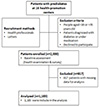1. Korean Diabetes Association. Diabetes. 5th ed. Seoul: PanMun;2018.
2. Bahar A, Makhlough A, Yousefi A, Kashi Z, Abediankenari S. Correlation between prediabetes conditions and microalbuminuria. Nephrourol Mon. 2013; 5(2):741–744.

3. Markus MRP, Ittermann T, Baumeister SE, Huth C, Thorand B, Herder C, et al. Prediabetes is associated with microalbuminuria, reduced kidney function and chronic kidney disease in the general population The KORA (Cooperative Health Research in the Augsburg Region) F4-Study. Nutr Metab Cardiovasc Dis. 2018; 28(3):234–242.
4. Kim CH, Kim KJ, Kim BY, Jung CH, Mok JO, Kang SK, et al. Prediabetes is not independently associated with microalbuminuria in Korean general population: the Korea National Health and Nutrition Examination Survey 2011-2012 (KNHANES V-2,3). Diabetes Res Clin Pract. 2014; 106(2):e18–e21.

5. Kee YK, Han SH. Recent updates on diabetic nephropathy. J Korean Diabetes. 2017; 18(4):214–228.

6. Seo MH, Jee Y, Yoo BW, Hong SH, Cho CY, Cho YJ, et al. Relationship between body mass index and microalbuminuria in healthy adults. Korean J Fam Pract. 2018; 8(1):80–86.

7. Nah EH, Cho S, Kim S, Cho HI. Comparison of urine albumin-to-creatinine ratio (ACR) between ACR strip test and quantitative test in prediabetes and diabetes. Ann Lab Med. 2017; 37(1):28–33.

8. American Diabetes Association. Executive summary: standards of medical care in diabetes--2012. Diabetes Care. 2012; 35 Suppl 1:S4–S10.
9. Jensen JS, Feldt-Rasmussen B, Strandgaard S, Schroll M, Borch-Johnsen K. Arterial hypertension, microalbuminuria, and risk of ischemic heart disease. Hypertension. 2000; 35(4):898–903.

10. Bianchi S, Bigazzi R, Campese VM. Microalbuminuria in essential hypertension: significance, pathophysiology, and therapeutic implications. Am J Kidney Dis. 1999; 34(6):973–995.

11. Colosia AD, Palencia R, Khan S. Prevalence of hypertension and obesity in patients with type 2 diabetes mellitus in observational studies: a systematic literature review. Diabetes Metab Syndr Obes. 2013; 17(6):327–338.

13. Yang L, Chu TK, Lian J, Lo CW, Lau PK, Nan H, et al. Risk factors of chronic kidney diseases in Chinese adults with type 2 diabetes. Sci Rep. 2018; 8(1):14686.

14. Kramer H, Reboussin D, Bertoni AG, Marcovina S, Lipkin E, Greenway FL 3rd, et al. Obesity and albuminuria among adults with type 2 diabetes: the Look AHEAD (Action for Health in Diabetes) Study. Diabetes Care. 2009; 32(5):851–853.
15. Mohammedi K, Chalmers J, Herrington W, Li Q, Mancia G, Marre M, et al. Associations between body mass index and the risk of renal events in patients with type 2 diabetes. Nutr Diabetes. 2018; 8(1):7.

16. Won JC, Lee YJ, Kim JM, Han SY, Noh JH, Ko KS, et al. Prevalence of and factors associated with albuminuria in the Korean adult population: the 2011 Korea National Health and Nutrition Examination Survey. PLoS One. 2013; 8(12):e83273.

18. Kodama K, Tojjar D, Yamada S, Toda KJ, Patel CJ, Butte A. Ethnic differences in the relationship between insulin sensitivity and insulin response: a systematic review and meta-analysis. Diabetes Care. 2013; 36(6):1789–1796.

19. Lee YJ, Lim HJ, Park SI. Characteristics of non-obese diabetes in Korean population. Public Health Weekly Report. 2017; 10(30):780–787.
20. Eckel N, Mühlenbruch K, Meidtner K, Boeing H, Stefan N, Schulze MB. Characterization of metabolically unhealthy normal-weight individuals: risk factors and their associations with type 2 diabetes. Metabolism. 2015; 64(8):862–871.

21. World Health Organization. The Asia-Pacific perspective : redefining obesity and its treatment [Internet]. Sydney: World Health Organization, Regional Office for the Western Pacific;2000. Accessed Oct 11, 2019. Available from:
https://apps.who.int/iris/handle/10665/206936.
22. Stefan N, Schick F, Häring HU. Causes, characteristics, and consequences of metabolically unhealthy normal weight in humans. Cell Metab. 2017; 26(2):292–300.

23. Park J, Ahmadi SF, Streja E, Molnar MZ, Flegal KM, Gillen D, et al. Obesity paradox in end-stage kidney disease patients. Prog Cardiovasc Dis. 2014; 56(4):415–425.

24. Wu S, Dong K, Wang J, Bi Y. Tumor necrosis factor alpha improves glucose homeostasis in diabetic mice independent with tumor necrosis factor receptor 1 and tumor necrosis factor receptor. Endocr J. 2018; 65(6):601–609.
25. Panahi MH, Hadaegh F, Yavari P, Kazempour-Ardebili S, Mehrabi Y, Azizi F, et al. A Challenging interaction of chronic kidney disease with other metabolic disorders: paradoxes in cardiometabolic risk factors. Iran J Kidney Dis. 2016; 10(5):274–281.
26. Rhee CM, Ahmadi SF, Kalantar-Zadeh K. The dual roles of obesity in chronic kidney disease: a review of the current literature. Curr Opin Nephrol Hypertens. 2016; 25(3):208–216.
27. Belhatem N, Mohammedi K, Rouzet F, Matallah N, Al Baloshi A, Travert F, et al. Impact of morbid obesity on the kidney function of patients with type 2 diabetes. Diabetes Res Clin Pract. 2015; 108(1):143–149.

28. Wang Y, Chen X, Song Y, Caballero B, Cheskin LJ. Association between obesity and kidney disease: a systematic review and meta-analysis. Kidney Int. 2008; 73(1):19–33.









 PDF
PDF ePub
ePub Citation
Citation Print
Print




 XML Download
XML Download